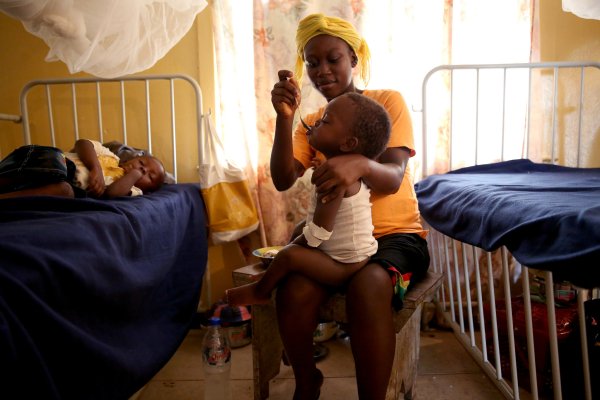Evidence to inform equitable dosing in very young and malnourished children
Pooled analysis identifies lumefantrine concentrations needed for curing malaria patients at highest risk

Effective treatment of malaria patients requires definition of the antimalarial concentrations required in patients’ blood to assure that they are cured. The doses needed to achieve these concentrations in most patients have been determined, but many factors can influence the drug exposure actually achieved even when the same weight-based (mg/kg) dose is given to each patient.
The studies that are conducted when a drug is licensed usually define the recommended doses based on adults, and for ethical reasons do not include important sub-populations such as infants, pregnant women, or patients with co-morbidities such as malnutrition or HIV co-infection. Pooled analyses of all available data, including post-marketing studies, are essential for dose optimisation in such vulnerable target population groups.
Artemether-lumefantrine is currently the most widely used of the artemisinin-based combination therapies, the frontline treatment against falciparum malaria. The concentration in patients of lumefantrine on day 7 post-treatment is an important indicator of drug exposure and therefore efficacy.
WWARN’s Lumefantrine Pharmacokinetic/Pharmacodynamic Study Group studied the threshold of this day 7 lumefantrine concentration in a large group of patients. Their findings were published recently in BMC Medicine. The group found that although this drug is still highly effective overall, there were three groups of patients who had lower concentrations of lumefantrine on day 7 and these patients were at higher risk of treatment failure. These subgroups were: very young children, particularly if they are underweight; patients who present with high numbers of malaria parasites in their blood; and patients who live in areas of very low malaria transmission intensity and with emerging antimalarial resistance.
“Our research provides health workers and researchers with an improved definition of the day 7 lumefantrine concentration threshold, which will help them to understand if treatment failure is caused by drug resistant malaria parasites or by inadequate drug concentrations,” says the University of Cape Town’s Prof Karen Barnes, Head of the WWARN Pharmacology Group. “This is an essential step for identifying vulnerable populations for whom current dosage recommendations are not yet optimal.”
The scale of this study is larger than any other pharmacology study on any antimalarial drug published previously. The pooled analysis includes data from 21 studies and more than 4,000 patients, over 90 percent of the world data on lumefantrine.
Although current recommended doses for lumefantrine are adequate to treat the vast majority of cases of uncomplicated malaria, this study outlines some ways to ensure that artemether-lumefantrine will continue to remain efficacious, especially in these three high risk patient groups. It is vital that treatment responses in these patients are monitored more closely, and that patients complete the full course of treatment, taking each dose with some food or milk.
“Several therapeutic options need to be evaluated such as higher, more frequent or prolonged dose regimens for very young children, particularly if they are malnourished, and for patients with high numbers of parasites in their blood,” says Prof Philippe Guérin, director of WWARN.
"Studies such as this day 7 lumefantrine concentration pooled analysis are critical for understanding the suitability of the existing drugs and the variability in treatment response among specific sub-populations like malnourished young children,” says Dr Kamal Hamed, Senior Global Medical Director at Novartis Pharmaceuticals Corporation. “Pooled analyses of individual patient data, like this one undertaken by WWARN, can provide insights into medicines currently on the market and provide lessons for new antimalarial treatments under development."
The WWARN Artemether-Lumefantrine (AL) Dose Impact Study Group recently published a study on the efficacy of this widely used combination therapy. This study pooled 61 studies on 14,327 patients and found that although AL is generally still working well, very young underweight children in Africa had a 4-fold higher risk of failing treatment.
By measuring the day 7 lumefantrine concentrations, the Lumefantrine PK/PD Study Group’s work complements the previous findings from the AL Dose Impact Group by explaining why certain groups of patients are at higher risk of treatment failure. Previously it was assumed that young children responded less favourably to malaria treatment simply because they had been exposed to fewer malaria infections and had lower immunity than adults. Now we know that there are additional factors that influence whether young children achieve adequate lumefantrine concentrations with the current recommended doses, particularly if they are malnourished.
“Our findings are of relevance to policy makers, medicines regulatory agencies and pharmaceutical manufacturers who share responsibility for guiding the use and dosing of artemether-lumefantrine, and other antimalarials, so that they remain effective for as long as possible,” says Lesley Workman, WWARN Pharmacology Coordinator.
The WWARN team are currently working with collaborators to better understand the drug exposure needed for other ACT partner drugs, piperaquine and amodiaquine, and to identify any population subgroups that may not achieve these concentrations. Find out more about these study groups and how you can get involved:
Publication details:
WWARN Lumefantrine PK/PD Study Group. 'Artemether-lumefantrine treatment of uncomplicatedPlasmodium falciparum malaria: a systematic review and meta-analysis of day 7 lumefantrine concentrations and therapeutic response using individual patient data'. Published in BMC Medicine 2015. 13:227 doi:10.1186/s12916-015-0456-7.

